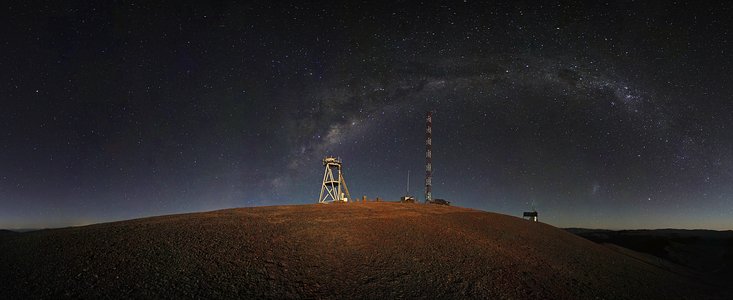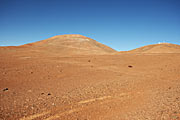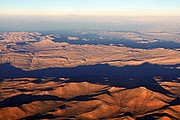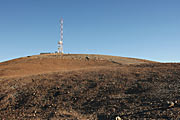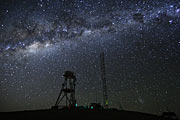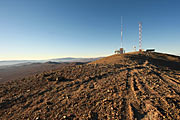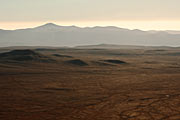Persbericht
E-ELT-locatie vastgesteld – De grootste telescoop ter wereld komt op Cerro Armazones in Chili
26 april 2010
De ESO-raad heeft Cerro Armazones uitgekozen als locatie voor de nieuwe 42-meter European Extremely Large Telescope (E-ELT). Cerro Armazones is een 3060 meter hoge berg in het centrale deel van de Atacama-woestijn in Chili, ongeveer 130 kilometer ten zuiden van de stad Antofagasta en zo’n 20 kilometer van Cerro Paranal, waar ESO’s Very Large Telescope (VLT) staat.
“Dit is een belangrijke mijlpaal die ons in staat stelt het basisontwerp van dit ambitieuze project, dat de astronomische kennis enorm zal bevorderen, af te ronden”, zegt ESO-directeur-generaal Tim de Zeeuw. “Ik dank het locatie-selectieteam voor zijn fantastische werk in de afgelopen jaren.”
De volgende stap voor ESO is de bouw van de E-ELT, een extreem grote optische/infrarood-telescoop met een hoofdspiegel met een diameter van 42 meter. De E-ELT wordt “het grootste oog op de hemel”- de enige telescoop in zijn soort ter wereld. ESO maakt momenteel samen met de astronomische gemeenschap gedetailleerde constructieplannen. De E-ELT zal zich richten op de meest urgente vragen binnen de astronomie en kan uiteindelijk onze kijk op het heelal revolutionair veranderen, net zoals Galilei’s telescoop dat 400 jaar geleden deed. Het uiteindelijke groene licht om te gaan bouwen wordt eind 2010 verwacht, en de ingebruikname in 2018.
De beslissing over de E-ELT-locatie is genomen door de ESO-Raad, waarin de veertien ESO-lidstaten zijn vertegenwoordigd en is gebaseerd op een uitgebreid vergelijkend meteorologisch onderzoek, dat een paar jaar in beslag heeft genomen. De meeste gegevens die tijdens de selectieperiode zijn verzameld, zullen in de loop van dit jaar openbaar worden gemaakt.
Bij de selectie van de locatie moesten verschillende factoren worden afgewogen. Daarbij ging het in de eerste plaats om de ‘astronomische kwaliteit’ van de atmosfeer, zoals het aantal heldere nachten, de hoeveelheid waterdamp en de ‘stabiliteit’ van de atmosfeer. Maar er moest ook rekening worden gehouden met de constructie- en operationele kosten, en de operationele en wetenschappelijke synergie met andere grote waarneemfaciliteiten (VLT/VLTI, VISTA, VST, ALMA, SKA etc.)
In maart 2010 kreeg de ESO-Raad een voorlopig rapport met de belangrijkste conclusies van het E-ELT Site Selection Advisory Committee [1]. Deze conclusies bevestigden dat alle onderzochte locaties van de uiteindelijke shortlist (Armazones, Ventarrones, Tolonchar en Vizcachas in Chili, en La Palma in Spanje) uitstekende locaties zijn voor astronomische waarnemingen, ieder met zijn eigen kracht. Het technische rapport concludeerde dat Cerro Armazones, bij Paranal, duidelijk de voorkeur heeft, omdat de waarneemcondities er het beste zijn en er kan worden geprofiteerd van de nabijheid van de faciliteiten van ESO’s Paranal-sterrenwacht. Cerro Armazones en Paranal delen dezelfde ideale omstandigheden voor sterrenkundige waarnemingen, met meer dat 320 heldere nachten per jaar.
Op basis van de duidelijke aanbevelingen van de locatieselectiecommissie en alle andere relevante aspecten, in het bijzonder de wetenschappelijke kwaliteit van de locatie, heeft de ESO-Raad gekozen voor Cerro Armazones als de E-ELT locatie [2].
“De wetenschappelijke mogelijkheden van de E-ELT in combinatie met de kracht van de VLT garanderen dat Paranal tot in de verre toekomst het meest geavanceerde optische/infrarood observatorium ter wereld zal zijn”, zegt De Zeeuw. “Dit zal ESO’s leidende positie met betrekking tot aardse telescopen verder versterken.”
Vooruitlopend op de keuze voor Cerro Armazones als de toekomstige locatie van de E-ELT en om het project te faciliteren en te steunen, heeft de Chileense regering ESO een uitgestrekt stuk grond geschonken, grenzend aan de Paranal Sterrenwacht, inclusief Armazones. Dit is gebeurd om de locatie te beschermen tegen nadelige invloeden, met name lichtvervuiling en mijnbouw.
Noten
[1] Het onafhankelijke E-ELT adviescomité dat de locatie bepaalde (SSAC) heeft resultaten van verschillende mogelijke locaties wereldwijd zeer gedetailleerd bestudeerd. Het Amerikaanse Thirty-Meter Telescope (TMT) comité heeft soortgelijk onderzoek gedaan. De locaties geselecteerd door het TMT-team (allemaal in Noord- en Zuid-Amerika) zijn niet door de SSAC bestudeerd, omdat het TMT team hun gegevens deelde met de SSAC. Twee locaties van de SSAC short list, inclusief Armazones, stonden ook op de TMT list.
[2] De volledige resolutie van de ESO-raad luidt (Engels):
Resolution of ESO Council on the Baseline Site for the E-ELT
Recognising
- the very clear recommendation from the Site Selection Advisory Committee that the E-ELT should be located on Cerro Armazones in Northern Chile
- the considerable scientific synergy that would result between the E-ELT and future facilities in the Southern Hemisphere, most notably ALMA and SKA
- the operational and scientific synergies with Paranal that would result
and expressing its warmest appreciation for
- the very generous offers from Spain and Chile to host the E-ELT
- the very considerable contributions to the quality and depth of the discussion on the siting of the E-ELT made by Chile and Spain in the course of developing their offers;
Council has concluded that the overriding driver for the decision on the location of the E-ELT should be the scientific quality of the site. The scientific qualities of Cerro Armazones and the positive impact that locating the E-ELT there will have on the future scientific leadership of ESO are sufficiently compelling to outweigh the very substantial offer made by Spain.
Council has therefore resolved to approve the recommendation of the Director General to adopt Cerro Armazones in Chile as the baseline site for the E-ELT.
Council noted that this decision is essential for the completion of the construction proposal for decision at a later date.
Meer informatie
ESO, de Europese Zuidelijke Sterrenwacht, is de belangrijkste intergouvernementele sterrenkundeorganisatie in Europa en wereldwijd het meest productieve astronomische observatorium. ESO wordt ondersteund door 14 landen: België, Denemarken, Duitsland, Finland, Frankrijk, Italië, Nederland, Oostenrijk, Portugal, Spanje, Tsjechië, het Verenigd Koninkrijk, Zweden en Zwitserland. ESO voert een ambitieus programma uit gericht op het ontwerp, de bouw en de exploitatie van krachtige grondobservatoria die astronomen in staat stellen om belangrijke wetenschappelijke ontdekkingen te doen. ESO speelt ook een leidende rol in het bevorderen en organiseren van samenwerking in het sterrenkundig onderzoek. ESO exploiteert drie observatielocaties van wereldklasse in Chili: La Silla, Paranal en Chajnantor. Op Paranal exploiteert ESO de Very Large Telescope (VLT), 's werelds meest geavanceerde optische observatorium, en VISTA, ’s werelds grootste survey telescoop. ESO is de Europese partner van de revolutionaire telescoop ALMA, het grootste astronomische project dat er bestaat.
Links
- More info in E-ELT media kit
- More info in our FAQ
- Take a virtual tour of Cerro Armazones
- Images about the E-ELT
- Videos about the E-ELT
Contact
Tim de Zeeuw
ESO Director General
Garching, Germany
Tel: +49 89 3200 6226
E-mail: ikreutle@eso.org
Massimo Tarenghi
ESO Representative in Chile
Santiago, Chile
Tel: +56 2 463 3143
E-mail: mtarengh@eso.org
Roberto Gilmozzi
E-ELT Principal Investigator
Garching, Germany
Tel: +49 89 3200 6667
E-mail: rgilmozz@eso.org
Lars Lindberg Christensen
Head ESO education and Public Outreach Department
Garching, Germany
Tel: +49 89 3200 6761
Mobiel: +49 173 38 72 621
E-mail: lars@eso.org
Henri Boffin
ESO La Silla-Paranal/E-ELT Press Officer
Garching, Germany
Tel: +49 89 3200 6222
Mobiel: +49 174 515 43 24
E-mail: hboffin@eso.org
Marieke Baan (Perscontact Nederland)
ESO Science Outreach Network
en NOVA Informatie Centrum
Tel: +31(0)20-5257480
E-mail: eson-netherlands@eso.org
Over dit bericht
| Persberichten nr.: | eso1018nl |
| Naam: | Cerro Armazones |
| Type: | Unspecified : Technology : Observatory |
| Facility: | Extremely Large Telescope |
Our use of Cookies
We use cookies that are essential for accessing our websites and using our services. We also use cookies to analyse, measure and improve our websites’ performance, to enable content sharing via social media and to display media content hosted on third-party platforms.
ESO Cookies Policy
The European Organisation for Astronomical Research in the Southern Hemisphere (ESO) is the pre-eminent intergovernmental science and technology organisation in astronomy. It carries out an ambitious programme focused on the design, construction and operation of powerful ground-based observing facilities for astronomy.
This Cookies Policy is intended to provide clarity by outlining the cookies used on the ESO public websites, their functions, the options you have for controlling them, and the ways you can contact us for additional details.
What are cookies?
Cookies are small pieces of data stored on your device by websites you visit. They serve various purposes, such as remembering login credentials and preferences and enhance your browsing experience.
Categories of cookies we use
Essential cookies (always active): These cookies are strictly necessary for the proper functioning of our website. Without these cookies, the website cannot operate correctly, and certain services, such as logging in or accessing secure areas, may not be available; because they are essential for the website’s operation, they cannot be disabled.
Functional Cookies: These cookies enhance your browsing experience by enabling additional features and personalization, such as remembering your preferences and settings. While not strictly necessary for the website to function, they improve usability and convenience; these cookies are only placed if you provide your consent.
Analytics cookies: These cookies collect information about how visitors interact with our website, such as which pages are visited most often and how users navigate the site. This data helps us improve website performance, optimize content, and enhance the user experience; these cookies are only placed if you provide your consent. We use the following analytics cookies.
Matomo Cookies:
This website uses Matomo (formerly Piwik), an open source software which enables the statistical analysis of website visits. Matomo uses cookies (text files) which are saved on your computer and which allow us to analyze how you use our website. The website user information generated by the cookies will only be saved on the servers of our IT Department. We use this information to analyze www.eso.org visits and to prepare reports on website activities. These data will not be disclosed to third parties.
On behalf of ESO, Matomo will use this information for the purpose of evaluating your use of the website, compiling reports on website activity and providing other services relating to website activity and internet usage.
Matomo cookies settings:
Additional Third-party cookies on ESO websites: some of our pages display content from external providers, e.g. YouTube.
Such third-party services are outside of ESO control and may, at any time, change their terms of service, use of cookies, etc.
YouTube: Some videos on the ESO website are embedded from ESO’s official YouTube channel. We have enabled YouTube’s privacy-enhanced mode, meaning that no cookies are set unless the user actively clicks on the video to play it. Additionally, in this mode, YouTube does not store any personally identifiable cookie data for embedded video playbacks. For more details, please refer to YouTube’s embedding videos information page.
Cookies can also be classified based on the following elements.
Regarding the domain, there are:
- First-party cookies, set by the website you are currently visiting. They are stored by the same domain that you are browsing and are used to enhance your experience on that site;
- Third-party cookies, set by a domain other than the one you are currently visiting.
As for their duration, cookies can be:
- Browser-session cookies, which are deleted when the user closes the browser;
- Stored cookies, which stay on the user's device for a predetermined period of time.
How to manage cookies
Cookie settings: You can modify your cookie choices for the ESO webpages at any time by clicking on the link Cookie settings at the bottom of any page.
In your browser: If you wish to delete cookies or instruct your browser to delete or block cookies by default, please visit the help pages of your browser:
Please be aware that if you delete or decline cookies, certain functionalities of our website may be not be available and your browsing experience may be affected.
You can set most browsers to prevent any cookies being placed on your device, but you may then have to manually adjust some preferences every time you visit a site/page. And some services and functionalities may not work properly at all (e.g. profile logging-in, shop check out).
Updates to the ESO Cookies Policy
The ESO Cookies Policy may be subject to future updates, which will be made available on this page.
Additional information
For any queries related to cookies, please contact: pdprATesoDOTorg.
As ESO public webpages are managed by our Department of Communication, your questions will be dealt with the support of the said Department.
